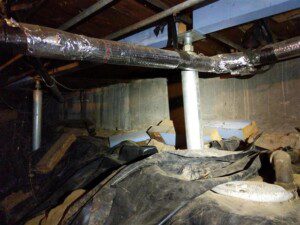
Lally columns, in some jurisdictions, can be permanently installed to correct structural problems. Some of the first types of lally columns were a non-adjustable steel column filled with concrete. However, the term “Lally Column” has come to refer to many other iterations of mobile steel columns, such as: adjustable steel columns, teleposts, and jack posts.
Contrary to their reputation, most lally columns are not to be used for the initial lifting process. A hydraulic or house jack should be used to raise the structure, then the steel column inserted. After the column is in place, it can then be used to make small adjustments with the screw jack portion.
Steel columns typically range from 3-14 feet tall. The shorter the column, the greater the weight it can support. For example, a column produced by LallyCorp, 6 foot long and 4-inches in diameter has a maximum weight rating of 24,600 pounds. Increasing the length of the column to 14 feet, drops its weight rating to 10,900 pounds.

When inspecting steel columns of any variety, there are several defective conditions that could be present but easily overlooked. According to the IRC, all adjustable steel columns should be protected by rust-inhibitive paint. The code says, specifically, “All surfaces (inside and outside) of steel columns shall be given a shop coat of rust-inhibitive paint, except for corrosion-resistant steel and steel treated with coatings to provide corrosion resistance.” If rust or heavy corrosion is present, the paint (if present) may be the wrong type or incorrectly applied.
Any bent, bowed or damaged components may be an indication of an overload condition. The post should also be installed plumb, a tight tolerance of 1/500 is typically allowed, when a column is installed a bit out of plumb, it can shoot away like a rocket when subjected to the weight of a structure. As with any load bearing post or column, proper fastening techniques to prevent displacement should be applied when securing the bottom to the footing and top to the beam or point load. There is a possibility that an adjustable post may be extended past the manufacturers allowable range, this condition may be difficult to determine unless technical data is available.
